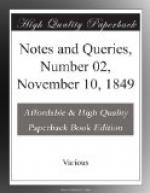We have still in the Town Hall here the chain in which it is said Jefferies sat at the Bloody Assize.
A. D. M.
Dorcester, 3d Nov. 1849.
[We shall gladly receive the particulars which our Correspondent proposed to collect and forward.]
* * * * *
SERPENTS’ EGGS AND STRAW NECKLACES.
[Mr. Thoms’ Query in this case should have been limited to the straw necklaces, as Mr. Nichols has already explained the serpents’ eggs; but our Correspondent’s letter is so satisfactory on both points that we insert it entire.]
The passage from Erasmus, “brachium habet ova serpentum,” is plainly to be rendered “and with a string of serpents’ eggs on your arm.” The meaning is equally apparent on recalling the manner in which snakes’ eggs are found, viz., hanging together in a row. Erasmus intends Menedemus to utter a joke at the rosary of beads hanging over the pilgrim’s arm, which he professes to mistake for serpents’ eggs.
I am not aware what particular propriety the “collar or chaplet” (for it may mean either) of straw may have, as worn by a pilgrim from Compostella; or whether there may not lurk under this description, as beneath {25} the other, a jocular sense. The readiest way of determining this point would be to consult some of the accounts of Compostella and of its relics, which are to be found in a class of books formerly abundant in the north-western towns of Spain.
V.
* * * * *
MADOC—HIS EXPEDITION TO AMERICA.
“A Student” may consult the Proceedings
of the Royal Society of
Northern Antiquaries, Copenhagen, Mr. Geogehan’s
Ireland,
O’Flaherty’s Ogygia, Magnusen and
Rafn On the Historical Monuments of
Greenland and America, and some of the Sagas.
SCOTUS.
Brechin, Nov. 5. 1849.
* * * * *
NOTES ON COFFEE.
The earliest account we have of coffee is said to
be taken from an
Arabian MS. in the Bibliotheque du Roi in Paris.
Schehabeddin Ben, an Arabian author of the ninth century of the Hegira, or fifteenth of the Christians, attributes to Gemaleddin, Mufti of Aden, a city of Arabia Felix, who was nearly his contemporary, the first introduction into that country, of drinking coffee. He tells us, that Gemaleddin, having occasion to travel into Persia, during his abode there saw some of his countrymen drinking coffee, which at that time he did not much attend to; but, on his return to Aden, finding himself indisposed, and remembering that he had seen his countrymen drinking coffee in Persia, in hopes of receiving some benefit from it, he determined to try it on himself; and, after making the experiment, not only recovered his health, but perceived other useful qualities in




